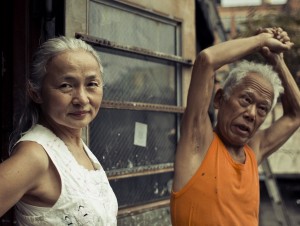‘Cutie and the Boxer’ Delivers a Paint-Infused Knockout
Ushio Shinohara sure knows how to turn a canvas black and blue. And no, I’m not talking about his preferred color scheme.
A Tokyo-born “boxing” painter, Shinohara uses a high-octane technique that sees him repeatedly pummel tableaus from right to left with paint-covered boxing gloves, wielded like artistic wrecking balls to produce chaotic splotches of color. (Meet Jackson Pollock on steroids.)
But, as the title of Zachary Heinzerling’s documentary Cutie and the Boxer connotes, the “Boxer” isn’t the sole subject of this endearing and observational film; Noriko Shinohara, Ushio’s wife of 40 years, is an integral part of the story, an intimate portrayal of the complicated-yet-loving relationship between these two Japanese artists. And boy, theirs certainly is a fascinating tale.
Heinzerling introduces us to the Shinoharas in present-day Brooklyn, where they reside in a dilapidated, graffitied apartment that also functions as a quasi-art studio and art storage sanctuary. Ushio is the epitome of New York’s “starving artist” — a romantic notion until you witness the poverty and frustration that can accompany the label; a shot of a leaking roof and countless conversations about work not selling, and we’re more than convinced that the lifestyle isn’t all too glamorous.
It wasn’t always this way, though; Ushio’s avant-garde boxing murals had earned him respect and notoriety in postwar Japan and, in pursuit of international acclaim, the artistic heavyweight moved to New York City in 1969. Here, his “action art” gained prominence in metropolitan art circles in the early ‘70s and launched his fledgling career to relative stardom. Noriko, who set out for the Big Apple from Japan in 1972 to receive an art education, met the vivacious, spirited Ushio at the pinnacle of his celebrity and swiftly abandoned her schooling to marry the craftsman (who’s 21 years older than the serene, quietly contemplating Noriko).
Now, decades later, Ushio’s compositions still garner praise (a representative from the Guggenheim in New York even surveys the artist’s studio for potential additions to the esteemed museum’s collection), but his career has long been stagnant. As the bruiser toils relentlessly to reclaim his former prominence, through the usual repertoire of boxing paintings and motorcycle sculptures crafted out of cardboard scraps, Noriko — who’s always been known as her attention-seeking husband’s “assistant” — experiences an artistic enlightenment of her own; her autobiographical, comic-style illustrations, which focus on the characters “Cutie” and “Bullie” (“Bullie” being a play on “bull,” or ushi in Japanese, as a reference to Ushio), begin to catch the eye of household visitors and art exhibitionists. Ultimately, the film culminates in the first joint exhibition of the duo’s artwork, highlighting the incredible talent of both Ushio and Noriko and helping the latter step from behind her husband’s shadow and into the limelight.
In his first turn as a feature documentarian, Heinzerling transmits the Shinoharas’ story with the skill and fine touch of a practiced director. Blending present-day sequences with archival footage and animations of Noriko’s black-and-white drawings, the freshman weaves a well-balanced, charming narrative that explores the intersection of artistic and domestic life, the strength of the creative spirit, the artistic identity and, most importantly, the complexities of this captivating, at-times-rocky marriage. One of the most impressive aspects of Heinzerling’s handiwork — a five-year-long endeavor from start to finish — is his wholly unobtrusive storytelling; indeed, viewers will feel like a fly on the paint-flecked wall of the Shinohara household. Absent unnecessarily flashy or overdone elements, Noriko and Ushio take center stage, an important quality in a character-driven production such as this.
The interactions between the energetic, strong-willed “Boxer” — at 80-years-old, he still spars with the liveliness of a man a quarter of his age — and the gracious, sharp-witted “Cutie” make this documentary a delight to watch. Opposites attract, as they say, and we’re certainly witness to it here. Underneath the comedic exchanges and lighthearted quips, though, lies a darker past (Ushio’s alcoholism, for example) that gives a layered density to the relationship, one that’s slowly revealed and peeled away throughout the film’s 82 minutes.
Overall, Heinzerling’s documentary is like one of Ushio’s “boxer” creations — a drip of warmth and humor here, a glob of pain and struggle there and we have a refreshingly honest, feel-good cinematic collage that delivers a veritable knockout.
Rating 3.5 out of 4 stars
“Cutie and the Boxer” opens in select theatres on August 16.
Trailer Courtesy of Film Festival Videos and Radius-TWC.
Featured image: Noriko and Ushio Shinohara in “Cutie and the Boxer.” Photo Courtesy of: RADiUS-TWC.

